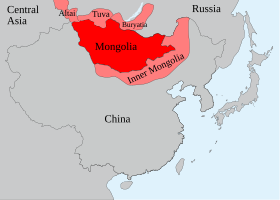

Pan-Mongolism is an irredentist idea that advocates cultural and political solidarity of Mongols.[1][2] The proposed territory, called "Greater Mongolia" (Mongolian: Даяар Монгол, Dayaar Mongol) or "Whole Mongolia" (Хамаг Монгол) usually includes the independent state of Mongolia,[3] the Chinese region of Inner Mongolia, and the Russian region of Buryatia.[4] Sometimes the autonomous republic Tuva, the Altai Republic and parts of Xinjiang, Zabaykalsky Krai, and Irkutsk Oblast are included as well.[5] As of 2006[update], all areas in Greater Mongolia (or Mongol heartland) except Mongolia have non-Mongol majorities.[4]
The nationalist movement emerged in the 20th century in response to the collapse of the Qing dynasty and the possibility of an independent Mongolian state. After the Red Army helped to establish the Mongolian People's Republic, Mongolian foreign policy prioritised seeking recognition of independence over territorial expansion. After the 1990 Mongolian Revolution ended Communist rule in Mongolia, a number of organizations have emerged that promote pan-Mongolism, but they have little popular support.
- ^ Kaplonski, Christopher (2004). Truth, History, and Politics in Mongolia. Psychology Press. p. 15.
- ^ Black, Cyril; Dupree, Louis; Endicott-West, Elizabeth; Naby, Eden (1991). The Modernization of Inner Asia. M.E. Sharpe. p. 193.
- ^ Cite error: The named reference
llswas invoked but never defined (see the help page). - ^ a b Steiner-Khamsi, Gita; Stolpe, Ines (2006). Educational Import: Local Encounters with Global Forces in Mongolia. Macmillan. p. 12.
- ^ Cite error: The named reference
tgtwas invoked but never defined (see the help page).